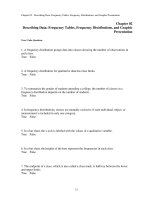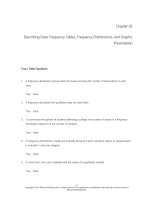Lecture Statistical techniques in business and economics - Chapter 18: Time series
Bạn đang xem bản rút gọn của tài liệu. Xem và tải ngay bản đầy đủ của tài liệu tại đây (3.16 MB, 33 trang )
18 1
Copyright © 2003 by The McGrawHill Companies, Inc. All rights reserved.
Copyright © 2004 by The McGrawHill Companies, Inc. All rights reserved.
18 2
When you have completed this chapter, you will be able to:
1.
2.
3.
Define the four components of a time series
4.
Compute the trend equation for a nonlinear trend
5.
6.
7.
8.
9.
Use trend equations to forecast future time periods and to
develop seasonally adjusted forecasts
Determine a linear trend equation
Compute a moving average
Determine and interpret a set of seasonal indexes
Identify cyclical fluctuations
Deseasonalize data using a seasonal index
Compute and evaluate forecasts
Copyright © 2004 by The McGrawHill Companies, Inc. All rights reserved.
18 3
… is a collection of data recorded over a period of time
( data may be recorded weekly, monthly, or quarterly)
…is the long run direction of the Time Series
…is the fluctuation above and below
the trend line
…is the pattern in a time series;
these patterns tend to repeat
themselves from year to year
Copyright © 2004 by The McGrawHill Companies, Inc. All rights reserved.
18 4
Continued…
…is divided into two components:
Episodic variations
… are unpredictable, but can usually be identified,
such as a flood or hurricane
Residual variations
… are random in nature and cannot be identified
Copyright © 2004 by The McGrawHill Companies, Inc. All rights reserved.
18 5
Text Chart 181… Excel
Secular Trend
Copyright © 2004 by The McGrawHill Companies, Inc. All rights reserved.
18 6
Text Chart 182 Excel
Secular Trend …
almost constant
Copyright © 2004 by The McGrawHill Companies, Inc. All rights reserved.
18 7
Text Chart 183 Excel
Secular Trend …Increasing Trend
Copyright © 2004 by The McGrawHill Companies, Inc. All rights reserved.
18 8
Text Chart 184 Excel
Secular Trend …Declining Trend
Copyright © 2004 by The McGrawHill Companies, Inc. All rights reserved.
18 9
Text Chart 185 Excel
Cyclical Variation
Copyright © 2004 by The McGrawHill Companies, Inc. All rights reserved.
18 10
Figure 18-6
Text Chart 186 Excel
Seasonal Variation
Copyright © 2004 by The McGrawHill Companies, Inc. All rights reserved.
18 11
Linear Trend
The long term trend equation (linear)
Estimated by
the least squares equation for time t is:
y
b
a
a
bt
n ty
( y )( t )
n t 2 ( t)2
y
n
b
Copyright © 2004 by The McGrawHill Companies, Inc. All rights reserved.
t
n
18 12
The owner of Farley Homes would like a
forecast for the next couple of years of new
homes that will be constructed in the
Edmonton area.
Listed below are the sales of new homes constructed in
the area for the last 5 years.
Year
Sales ($1000)
1998
4.3
5.6
1999
7.8
2000
9.2
2001
9.7
1997
Copyright © 2004 by The McGrawHill Companies, Inc. All rights reserved.
Continued…
18 13
Continued…
…least squares equation for time
t
Year
Sales
t
Sales*t
t2
1997
1998
1999
2000
2001
Total
4.3
5.6
7.8
9.2
9.7
36.6
1
2
3
4
5
15
4.3
11.2
23.4
36.8
48.5
124.2
1
4
9
16
25
55
Continued…
Copyright © 2004 by The McGrawHill Companies, Inc. All rights reserved.
18 14
Develop a trend equation using the least
squares method by letting 1997 be the time period 1
Year
Sales ($1000)
1998
4.3
5.6
1999
7.8
2000
9.2
2001
9.7
1997
ty
b
t
y
2
t /n
t
2
/n
124.2 36.6(15) / 5
55 (15) 2 / 5
= 1.44
= 1.44
a
y
n
t
b
n
= 3.0
= 3.0
Copyright © 2004 by The McGrawHill Companies, Inc. All rights reserved.
36 .6
5
15
1 .44
5
nswer
18 15
nswer
The time series equation is:
= 3.00 + 1.44
t
y
The forecast for the year 2003 is:
y
= 3.00 + 1.44(7)
* = 13.08
* Five year (1997 – 2001) + 2002 and 2003
Copyright © 2004 by The McGrawHill Companies, Inc. All rights reserved.
18 16
Using
ls
o
o
T
n
o
k
c
i
l
C
See
See
Click on DATA
Click on DATA
ANALYSIS
ANALYSIS
See…
Copyright © 2004 by The McGrawHill Companies, Inc. All rights reserved.
18 17
See
See
Using
Highlight Regression …Click OK
Copyright © 2004 by The McGrawHill Companies, Inc. All rights reserved.
See…
18 18
See
See
Using
Data
Data
Line Fit Plot
Line Fit Plot
Copyright © 2004 by The McGrawHill Companies, Inc. All rights reserved.
Regression
Regression
18 19
Non-Linear Trend
If the trend is not linear but rather
the increases tend to be a constant
percent, the y values are
converted to logarithms, and a least squares
equation is determined using the lns:
ln( y ) [ ln( a)] [ ln( b)]t
Copyright © 2004 by The McGrawHill Companies, Inc. All rights reserved.
18 20
Text Figure 1811 Excel
Copyright © 2004 by The McGrawHill Companies, Inc. All rights reserved.
18 21
The MovingAverage Method
… is used to smooth out a time series.
This is accomplished
by “moving” the arithmetic mean through the
time series.
…the movingaverage is the basic method used in
measuring the seasonal fluctuation
…to apply the movingaverage method to a time
series, the data should follow a fairly linear trend
and have a definite rhythmic pattern of fluctuations
Copyright © 2004 by The McGrawHill Companies, Inc. All rights reserved.
Using
Text Chart 189 Excel
The MovingAverage Method
Copyright © 2004 by The McGrawHill Companies, Inc. All rights reserved.
18 22
18 23
The method most commonly used to compute the
typical seasonal pattern is called the
RatiotoMovingAverage Method
…it eliminates the trend, cyclical, and irregular
components from the original data (y)
…the numbers that result are called
the typical seasonal indexes
Copyright © 2004 by The McGrawHill Companies, Inc. All rights reserved.
18 24
Listed below are the quarterly sales (in $ millions)
of Toys International
for the years 1996 through 2001.
Determine a quarterly
seasonal index using the ratio
tomoving average method.
Year Winter Spring Summer Fall
Note
… that the fall
quarter sales are
the largest and
the spring sales are
the smallest
each year
1996
6.7
4.6
6.7
12.7
1997
6.5
4.6
6.5
13.6
1998
6.9
5.0
6.9
14.1
1999
7.0
5.5
7.0
15.0
2000
7.1
5.7
7.1
14.5
2001
8.0
.6.2
11.4
14.9
Copyright © 2004 by The McGrawHill Companies, Inc. All rights reserved.
18 25
Steps
1. …determine the moving total for the time series
2. …determine the moving average for the time series
3. …the moving averages are then centered
4. …the specific seasonal for each period is then computed
by dividing the y values
with the centered moving averages
5. … organize the specific seasonals in a table
6. … apply the correction factor
Copyright © 2004 by The McGrawHill Companies, Inc. All rights reserved.









